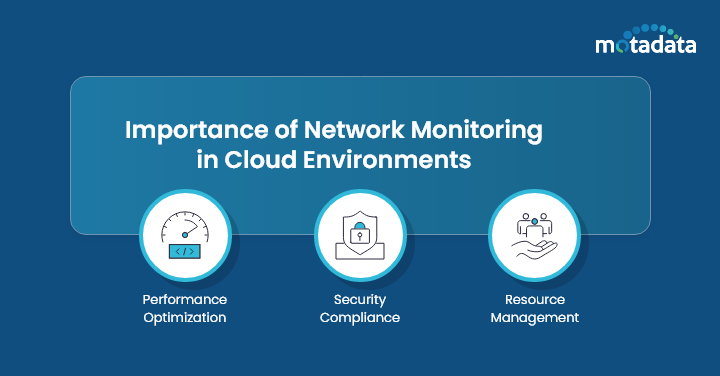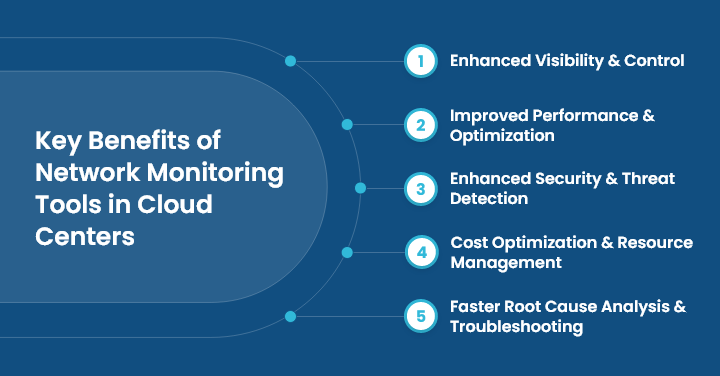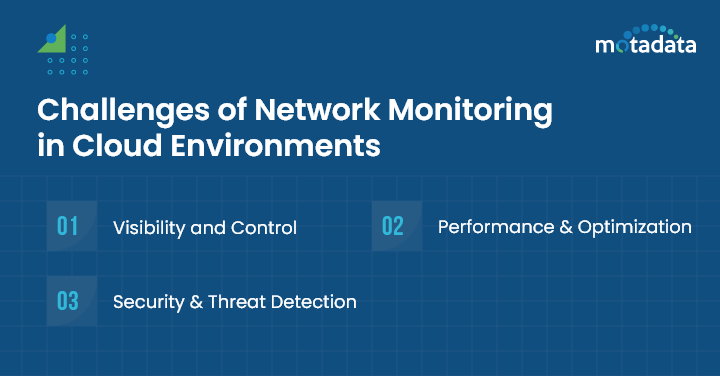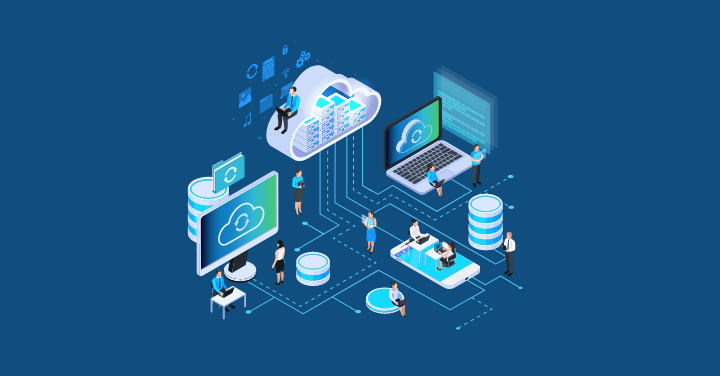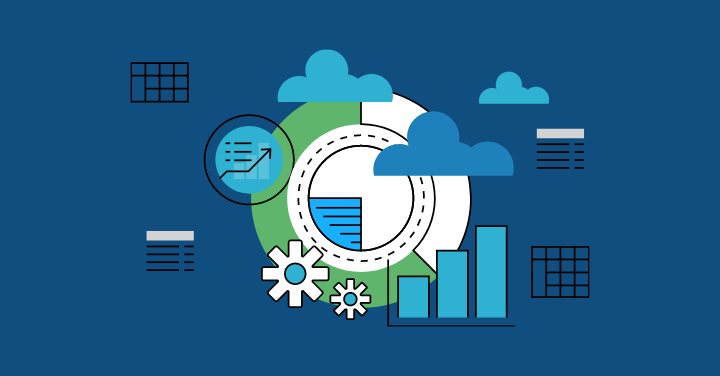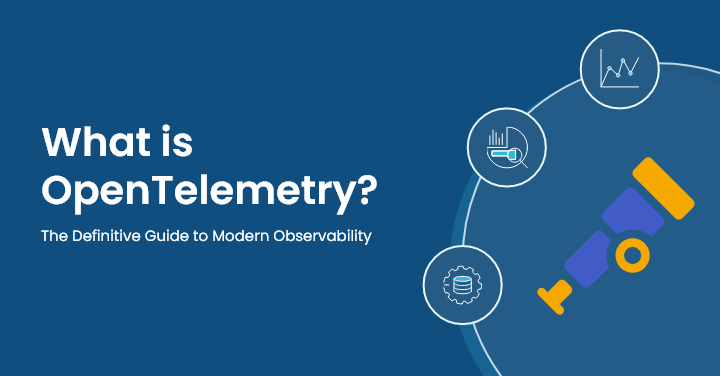In the past few years, our distributed enterprise market has experienced notable growth due to multiple factors.
More than 90% of organizations have integrated cloud computing practices to better manage their business data and operations.
With their scalability, flexibility, and affordability, cloud data centers have emerged as the mainstay of modern IT infrastructure.
However, embracing cloud tools and services offers multiple challenges to businesses.
Hence, to ensure optimal performance and network security, it is essential to invest in network monitoring solutions.
In this post, we will highlight the complexities of network monitoring in cloud environments.
Further, we will discuss the importance, role, and benefits of network monitoring tools in cloud environments.
Network Monitoring and Cloud Centers
Network performance monitoring is a crucial practice that allows administrators to manage and monitor the performance of their computer networks in real time.
The tools provide clear visibility into the network components, collect data from different sources, and proactively manage network performance.
With the help of these network monitoring tools, Data Center Managed Services providers can keep a real-time watch over the network operations, detect anomalies, and maintain network stability in cloud environments
A Cloud Data Center is a centralized location where all the information related to your web apps, databases, virtual machines, and more is stored, managed, and processed using cloud computing.
Also, referred to as data centers, these facilities use several storage devices, network equipment, and services to deliver cloud services to customers without any interruption.
Since network connectivity is a major component of cloud services, any problems with it can affect their availability and performance.
Hence, investing in network monitoring tools is highly crucial to detecting and responding to potential security threats and issues for smooth operations and delivering a seamless user experience.
Importance of network monitoring in cloud environments
In cloud environments, network monitoring is highly essential for all of its resources to be virtualized and allocated on-demand as needed.
Even a minor network problem can cause downtime and impact user experience.
Here are a few more reasons why network monitoring in cloud environments is important.
Performance Optimization
By proactively monitoring network traffic and resource usage in cloud environments, organizations can identify bottlenecks and network congestions at an earlier stage and ensure smooth data flow.
Thus, improving the overall performance of cloud-based applications and services.
Security Compliance
Since all your business data are stored and transferred over the Internet, chances of data breaches and intrusions are high.
With the help of network monitors, administrators can gain clear visibility into the traffic and detect malware infections and other security threats before they impact performance.
Resource Management
By constantly monitoring network components, a cloud center can gain a clear idea of resource usage and accordingly work on the expenses and resource distribution.
It further helps forecast the capacity requirements of the resources, helps reduce unnecessary costs and maximizes efficiency.
Role of Network Monitoring Tools in Cloud Centers
Network monitoring tools come with a wide range of key features that help organizations manage the different cloud computing and other challenges of cloud environments.
Key roles of Network Monitoring Tools in Cloud Centers include:
Real-time Visibility into Network Performance
Network monitoring software provides real-time visibility into different applications, servers, and databases.
With these insights, organizations can gain a better understanding of network health status, traffic, and other issues.
The major advantage of this feature is that it helps identify performance bottlenecks and respond to cloud infrastructure problems in real time.
Basically, with continuous monitoring, organizations can proactively control network performance to maintain a flawless user experience.
Security Monitoring and Threat Detection
Network monitors constantly run scans over the servers, networks, databases, and virtual machines to monitor unusual network activities.
With these scan results, organizations can quickly identify unauthorized access attempts, vulnerabilities, and malware outbreaks.
Identifying and addressing potential security breaches in real time will not only help save crucial data but ensure uninterrupted operations.
Key Benefits of Network Monitoring Tools in Cloud Centers
For businesses using cloud computing, network monitoring software offers many advantages.
From optimizing resource allocation to proactive issue identification and performance enhancement, there are several benefits to using network monitors.
1. Enhanced Visibility and Control
Network management tools collect data from different sources, including servers, applications, virtual machines, network devices, and other components in the cloud center for analysis.
It tracks data packets, bandwidth usage, latency, error rates, and other metrics to gain a better understanding of how the traffic and devices are performing.
These insights further help identify trends and patterns responsible for performance deterioration and capacity issues.
With granular visibility and control, network administrators are able to take immediate action and improve network health as well as user experience.
2. Improved Performance and Optimization
With the help of these tools, organizations can continuously monitor the different key metrics and identify issues promptly.
They also have built-in alert systems that instantly notify administrators about performance bottlenecks.
With these quick insights, the team can resolve issues before they impact the application’s performance.
Additionally, the tools provide updates related to resource usage and traffic patterns, facilitating forecasting capacity requirements, optimization, and ensuring constant performance delivery by cloud applications.
3. Enhanced Security and Threat Detection
The tool comes with an intrusion detection system and threat intelligence integration that help identify potential threats and breaches in real time.
Further, they support running performance scans to detect vulnerabilities.
They also have an alert system that notifies in real-time of suspicious activities.
By using this robust monitoring software, cloud data centers can identify and mitigate security threats before they impact performance or cause delays in cloud operations.
Further, they facilitate compliance with security standards and strengthen cloud centers’ overall security posture.
4. Cost Optimization and Resource Management
By constantly monitoring resource usage of cloud components, organizations can gain a better understanding of underutilized and overutilized resources.
With these insights, cloud centers can not only optimize resource utilization but also save on costs by eliminating unnecessary expenses and ensuring cloud environments operate at peak efficiency.
5. Faster Root Cause Analysis and Troubleshooting
These tools assist IT professionals in quickly identifying and resolving entire network issues, hence reducing downtime.
These monitoring solutions offer real-time visibility into network performance, which makes unusual patterns easier to spot.
The user experience and overall health of the network can be improved by this proactive approach.
System administrators can more easily manage network efficiency and network availability by speeding up the troubleshooting process with the ability to generate performance metrics and analyze traffic patterns.
Challenges of Network Monitoring in Cloud Environments
When comparing network monitoring in cloud environments to traditional on-premises networks, there are a few distinct challenges.
Here are some important things to consider:
1. Visibility and Control
- Distributed infrastructure – Since cloud resources are distributed or spread across geographically data centers, it is quite challenging or difficult for administrators to gain a better understanding or holistic view of their network performance and health.
- Dynamic infrastructure – Maintaining consistent monitoring setups and baselines is challenging due to the constantly increasing and changing nature of cloud resources and dynamic cloud environments.
- Multi-tenancy – Administrators share a lot of data and resources over the Internet which also increases the risk of security threats. Ensuring proper monitoring at all times of resource usage and other aspects in a cloud environment is another challenge.
2. Performance and Optimization
- Variable performance – There are several factors that might contribute to fluctuation in cloud performance, for example, shared resources, network congestion, or varying service levels. In such a case, identifying the real cause of performance issues is another challenge.
- Limited control – Customers are limited in their capacity to fully customize and optimize the network infrastructure because cloud providers manage a portion of it. This restriction results from relying too much on provider-managed services, which are convenient but limit the options for customizing network configurations and performance enhancements to meet unique requirements.
- Monitoring cost – Continuous monitoring can produce a large amount of data, which raises the cost of processing and storage.
3. Security and Threat Detection
- Increased attack surface – Since cloud infrastructures allow for remote access and sharing of resources over a large audience, they expose a larger attack surface to potential breaches.
- Shared responsibility model – Users and providers must share accountability for cloud security. Data, apps, and access controls must be secured by users; providers handle the security of the underlying infrastructure. To properly safeguard cloud environments, it is imperative that both parties comprehend their respective duties, work together on monitoring efforts, and apply the necessary security measures.
- Evolving threats – The dynamic nature of cloud environments necessitates constant modifications to monitoring strategies and tools. Because of their dynamic nature, many risks require ongoing attention to detail and flexibility in order to effectively detect and mitigate them. For cloud environments to maintain a strong security posture, regular upgrades to monitoring tactics and technologies are essential.
Best Practices for Network Monitoring in cloud environments
Here are a few best practices that guarantee your cloud monitoring system performs as intended, including:
1. Identify KPIs that may affect user experience
There are many things to keep an eye on in cloud systems, but not all of them need your whole focus.
Prioritizing will become evident when you specify which KPIs and metrics you wish to monitor before putting a cloud monitoring solution into place.
2. Monitoring cloud service usage and fees
Cloud computing is scalable, i.e., as usage grows, expenses may also rise. So, be sure your cloud monitoring system is keeping track of consumption patterns and related expenses.
3. Real-time Alerts
Set up real-time alerting features in your platform to inform users about anomalies and performance problems.
You may also set Establish alerting policies that are triggered by particular events, i.e., threshold breaches.
4. Reports and Dashboards
Visualize all your data and represent it in different formats such as graphs, charts, and diagrams for analysis and better understanding of data flow and traffic analysis across large networks on your customizable dashboards.
5. Use a centralized platform
In order to have a comprehensive understanding of cloud performance, it is essential to ensure that all of your cloud monitoring data gathered from several sources is stored in one place and is easily accessible and consistent.
Also, select the platforms and tools for comprehensive network monitoring that best fit the scope, complexity, and needs of your cloud.
Choosing the Right Network Monitoring Tool for Your Cloud Center
There are several factors that one must take into account while choosing the best network monitoring tool, including:
1. Monitoring Features
Make sure to invest in a tool that comes with real-time monitoring capabilities.
With the help of this feature, cloud centers can identify issues in different servers, databases, and virtual machines in real time as well as troubleshoot them before they escalate.
Also, they support alert systems and other features that will aid in the monitoring process.
2. Supports Integration
Make sure that your selected tool integrates well with existing cloud infrastructure and tools for smooth operations.
Also, ensure that it is compatible with other cloud service providers.
3. Scalability and adaptability
It is highly recommended to invest in a tool that scales as you grow and adapts the new changes for smooth operations.
Basically, the operational needs and requirements of your firm will undoubtedly change as it grows and develops.
So, ensure it is scalable and adaptable to meet your future needs.
4. Alert System
Another key factor to keep in mind is the customizable alert option.
It is recommended to invest in network management software that triggers real-time alerts and supports multiple channels for notifying IT Managers about the issues.
5. Insightful Reporting and Analytics
Having a tool with advanced analytics capabilities allows users to identify unusual traffic patterns, performance bottlenecks, and security threats easily.
Further, a comprehensive reporting system helps present these insights in a better visual manner that further aids in making effective decisions.
6. Cost and pricing models
There are several cloud networking tools available in the market, for example, Paessler PRTG, Nagios XI, Manageengine Opmanager, Whatsup Gold, and more, so make sure to compare their cost and pricing models before making a final call. Also, cross-check if the features are worth the pay.
Conclusion
Tools for network monitoring are essential for guaranteeing cloud data centers run smoothly and without any disruption.
These technologies are essential for effective network management because they improve security, optimize performance, and offer real-time insights.
Further, these network monitoring solutions provide advantages like better performance, increased control, better security, and cost savings.
Selecting the appropriate network performance monitors is essential, regardless of challenges like visibility and security.
You can find several such monitoring and management tools that also offer free trials and demo sessions for users before final purchase.
In simple terms, network monitoring solutions are crucial for preserving the integrity and effectiveness of cloud settings since they may help with troubleshooting, diagnostics, and cost control which may eventually improve user experience.
FAQs
With the use of network monitoring technologies, managers may quickly detect and resolve network problems by getting real-time visibility into network performance aspects.
These tools assist administrators in identifying the underlying cause of network issues and implementing the necessary corrective measures by continuously monitoring network traffic, bandwidth utilization, and application performance.
This reduces downtime and guarantees the smooth operation of cloud systems by enabling quicker troubleshooting and diagnostics.
Network monitoring solutions provide real-time visibility into the bandwidth and resource usage as well as other performance metrics. It runs scans to identify unnecessary resource consumption and additional inefficiencies. The insights collected from these metrics are further used by administrators for optimizing resource allocation and saving on unnecessary costs.
Unlike on-premises, cloud services are a bit dynamic in nature and have distributed resources. Further, the need to monitor network traffic coming from different cloud providers makes network device monitoring in the cloud more challenging than on-premises. Additional complexity in network management, security, and performance optimization are also brought about by cloud systems.
Here are some of the biggest security concerns and difficulties related to cloud network monitoring:
- The cloud environment is not compatible with the traditional security methods employed in data centers. To meet the specific needs of cloud computing data security, cloud administrators need to develop new approaches and skill sets.
- It can be difficult to create the right roles and permissions for a large company with thousands of employees. Hence, establishing a comprehensive IAM strategy is crucial, but its implementation can be challenging.
- The absence of formal IT approval and management protocols in the case of shadow IT presents security risks.
- If appropriate access control measures are not in place, monitoring network access can become a major issue.



